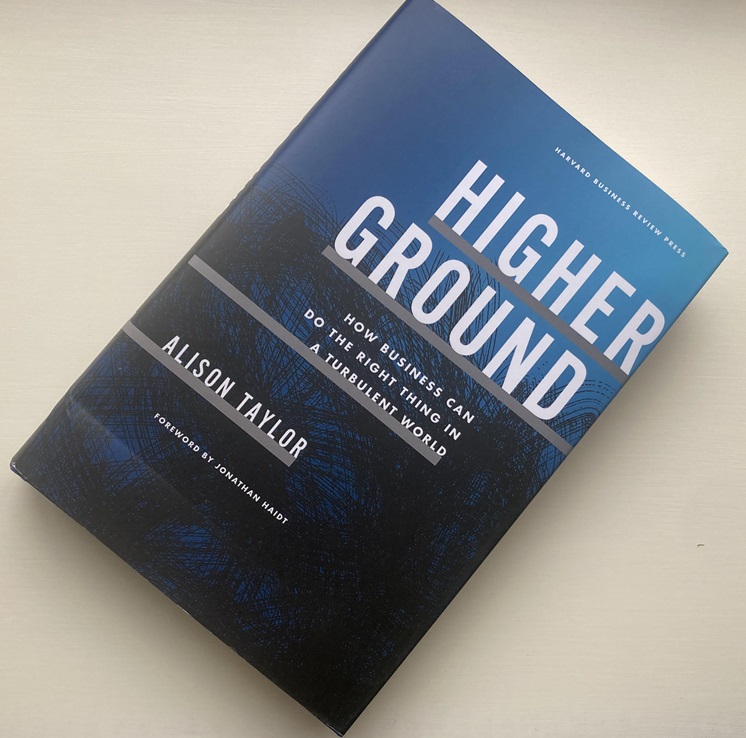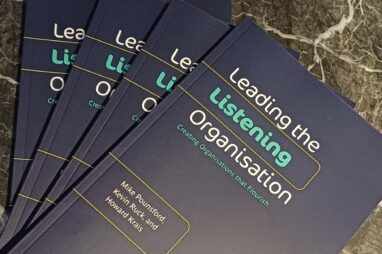Review: Higher Ground

About the author
Richard Bailey Hon FCIPR is editor of PR Academy's PR Place Insights. He teaches and assesses undergraduate, postgraduate and professional students.

Higher Ground: How Business Can Do The Right Thing In A Turbulent World
Alison Taylor
Harvard Business Review Press, 2024, 285 pages
Profit – or purpose?
What is the role of business in society?
While capitalism has enabled many to rise out of poverty, it has also disproportionately benefited the few. While private profits provide a public good through taxation, global growth has also precipitated the climate emergency.
So it’s a difficult scorecard to mark and there’s added complexity from the alphabet soup of initiatives from CCI to CSR to ESG designed to demonstrate the responsibility of business. And does purpose have any meaning beyond being a marketing gimmick?
This is the bumpy terrain that Alison Taylor, a professor at Stern School of Business in New York, navigates in this admirable new book. She uses the metaphor of the challenging journey to the ‘higher ground’ throughout.
‘It made sense for a long time to treat branding, culture, sustainability, risk and ethics as separate disciplines that required distinct approaches’ she writes. ‘But internal teams can’t afford to pursue misaligned agendas for long in a digitally paced world. Any company lacking rigorous internal coordination will soon look disjointed and hypocritical.’
That is the challenge in a nutshell facing public relations and communication specialists. It requires joined-up thinking.
‘Companies are expected to balance conflicting stakeholder interests and demands; to follow clear global principles while adapting to local conditions and cultures; to solve societal problems while maintaining shareholder value; and to be transparent and authentic, with no empty talk or inconsistencies.’
Communicators will also welcome her analysis of corporate value and the role of intangible assets such as brand, reputation and relationships.
Having reviewed the complexity of the global landscape (once you’d closed down your operations in Russia, how could you defend your continuing business in China and Saudi Arabia?) she turns to the ‘sharply polarized US environment’ where abortion has become a corporate issue because of the importance of private healthcare; and where politicised debates over gun control leave companies with difficult decisions over whether to allow firearms in their offices.
Companies are being forced to take stances on positions that were once off limits and political. Yet ‘it’s very hard to draw back from taking stands once you’ve begun. Proclamations that core values are as important and fundamental as profit shifted the Overton window (the range of ideas and policies the public will accept at a given moment).’
Doing the right thing is far more demanding than it looks.
She casts a critical eye on some business cliches, starting with stakeholder engagement.
‘“Stakeholders” is an elusive buzzword. A stakeholder can be defined as someone who has an interest in your business today – or might tomorrow. By this definition, all companies “engage” their stakeholders… While there’s a risk in having key interest groups saying you’re ignoring them, it’s riskier to anchor your decisions in the shifting sands of opinion. That would never please everyone and might well leave you looking skittish and indecisive.’
Next she turns to ESG and sustainability. When challenged to make the case that a focus on environmental, social and governance performance would inevitably lead to increased profits, ‘I realized that we’d maneuvered ourselves into a circular argument that shareholder returns are the best way to evaluate an approach originally conceived as a counterweight to the overwhelming obsession with … shareholder returns.’ Ouch.
It seems there are no easy answers. ‘If expecting so much from companies is unrealistic, and balancing stakeholder expectations impossible, was Milton Friedman right after all?’
The question is left hanging, but the book has some clear and positive advice for cutting through the complexity. How about this for a clear-headed approach to business ethics?
‘Being an ethical business is about undertaking a process of discovery about your real-world impact and then basing your values and supporting principles on what you find.’
She’s critical of so much corporate public relations: ‘Managing reputational risk is a contained activity. It treats corporate messaging as an end in itself that’s divorced from questions of a company’s underlying conduct. A domain of PR focuses on “reputation laundering”.’ That said, ‘a company that makes the effort to understand its impacts on stakeholders and aims to build trust (rather than merely enhance its reputation) is likely to prove resilient.’
It’s a change in mindset from focusing on risks to organisations to the impacts of organisations – the ‘stakeholder capitalism’ approach.
How do you effect this transition? By listening to key stakeholders and treating their views with respect, and by conducting network analysis to understand not only which groups the organisation influences but which groups influence each other. She recommends establishing a stakeholder advisory panel of critical friends.
The author is critical of conventional approaches to reporting financial results for shareholders and on environmental and social initiatives for other stakeholders. ‘If you read a company’s sustainability report and then peruse its core risk and financial disclosures, they commonly feel like discussions of two different companies. This split-screen approach is ever less credible.’
She describes the ‘elephant in the room’ as the tendency ‘to focus on the important at the expense of the existential’. For example ‘retailers address the environmental requirements they impose on their suppliers, not why they don’t pay employees a living wage.’ What’s needed is a rigorous materiality assessment (she provides a five step process for this, including a prioritisation matrix).
Corruption is addressed and in another departure from conventional thinking on ESG, Taylor recommends drawing on human rights frameworks ‘which offer significant advantages over ESG or compliance.’
Most contentious of all, she addresses what she calls Corporate Political Responsibility (and Irresponsibility). She summarises lobbying and advocacy thus: ‘There’s a place for ethical lobbying in a healthy democracy; politicians can learn much from business inputs on regulatory legislation and rulemaking. But lobbying can be used for unethical purposes and is frequently derided as influence peddling.’
Her talk of political action committees (PACs) was one of the few times I realised the author was writing from a country with very different democratic norms (she’s smart enough to acknowledge that she’d ‘focused on the uniquely fraught US context in this chapter.’)
She discusses transparency (and whisteblowing); ethical culture; leadership; compliance; employee voice and purpose in this wide-ranging analysis.
‘Rather than seeking to put a positive spin on what you’re up to in an effort to deflect reputational risk, you can head for higher ground by being focused and honest about what your business can actually achieve.’
Your employees are your most important stakeholders. What they think dramatically affects other stakeholder groups, including investors.
But don’t be so crass as to disregard your most important stakeholder group. ‘Your employees are your most important stakeholders. What they think dramatically affects other stakeholder groups, including investors.’
The author is no dry academic. When she describes some purpose statements as ‘bullshit’ she defends this by defining what she means by this word (‘not as a lie, but rather as a statement made without regard to the truth’).
She’s writing from firsthand experience of the complexity of compliance, and observes the disconnect between abstract moral philosophy and business decision making. ‘I have yet to attend a meeting where executives debate whether it’s better to apply a utilitarian or a deontological framework to a decision.’
Indeed, her credibility as an author is built on three legs: her professional experience, her academic research, and what she’s learnt from her students at New York University. It’s rare for an academic to acknowledge the symbiotic value of teaching.
She’s an admirable guide to this treacherous terrain. The book may not be explicitly about public relations – but this is just where we operate now. As she explains:
‘Back in the twentieth century, public relations was simply about effective communication, not underlying culture, values or behavior.’


